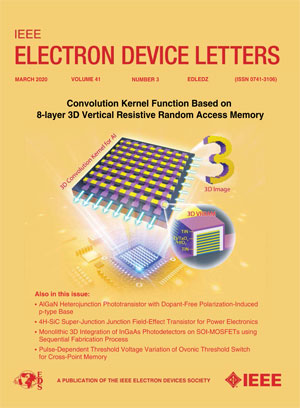利用氨等离子体表面处理的β-Ga₂O₃肖特基势垒二极管提高了性能
IF 4.5
2区 工程技术
Q2 ENGINEERING, ELECTRICAL & ELECTRONIC
引用次数: 0
摘要
在这项工作中,我们展示了高性能的垂直$\beta $ -Ga2O3肖特基势垒二极管(sbd),使用氨等离子体表面处理(APT)和自对准台面终端(MT)。APT将界面陷阱密度降低到$3.6\times 10^{{11}}$ cm ${}^{-{2}}$ eV ${}^{-{1}}$,而MT抑制了阳极边缘的峰值电场。这种组合导致击穿电压为2034 V,比导通电阻为3.31 m $\Omega \cdot $ cm2,实现了1.25 GW/cm2的高功率值。通过APT还原亚氧化镓和吸附氧,改善了Ni/ $\beta $ -Ga2O3 sbd的界面质量,使其具有优异的正向性能,理想因子达到1.012。这项工作强调了APT和MT结合的潜力,以增强$\beta $ -Ga2O3 sdd的功率应用。本文章由计算机程序翻译,如有差异,请以英文原文为准。
β-Ga₂O₃ Schottky Barrier Diodes Utilizing Ammonia Plasma Surface Treatment Yield Enhanced Characteristics
In this work, we demonstrate high-performance vertical $\beta $ -Ga2O3 Schottky barrier diodes (SBDs) using ammonia plasma surface treatment (APT) and self-aligned mesa termination (MT). The APT reduces the interface trap density to $3.6\times 10^{{11}}$ cm ${}^{-{2}}$ eV ${}^{-{1}}$ , while the MT suppresses the peak electric field at the anode edge. This combination results in a breakdown voltage of 2034 V with a specific on-resistance of 3.31 m $\Omega \cdot $ cm2, achieving a high power figure of merit of 1.25 GW/cm2. The reduction of Ga-suboxide and adsorbed oxygen improves the interface quality of Ni/ $\beta $ -Ga2O3 SBDs by APT, leading to excellent forward characteristics with an ideality factor reaching 1.012. This work highlights the potential of combining APT and MT to enhance $\beta $ -Ga2O3 SBDs for power applications.
求助全文
通过发布文献求助,成功后即可免费获取论文全文。
去求助
来源期刊

IEEE Electron Device Letters
工程技术-工程:电子与电气
CiteScore
8.20
自引率
10.20%
发文量
551
审稿时长
1.4 months
期刊介绍:
IEEE Electron Device Letters publishes original and significant contributions relating to the theory, modeling, design, performance and reliability of electron and ion integrated circuit devices and interconnects, involving insulators, metals, organic materials, micro-plasmas, semiconductors, quantum-effect structures, vacuum devices, and emerging materials with applications in bioelectronics, biomedical electronics, computation, communications, displays, microelectromechanics, imaging, micro-actuators, nanoelectronics, optoelectronics, photovoltaics, power ICs and micro-sensors.
 求助内容:
求助内容: 应助结果提醒方式:
应助结果提醒方式:


